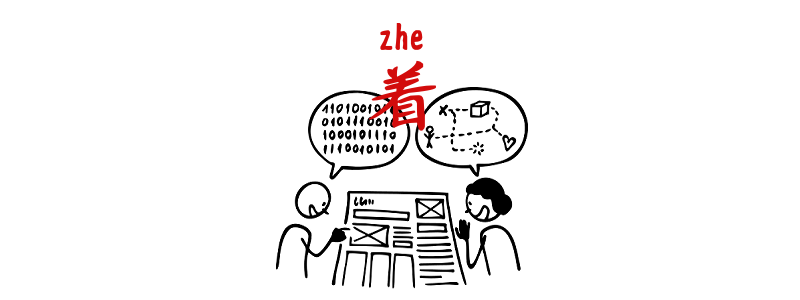Grammar Point:The aspect particle 著着 zhe is used to indicate ongoing actions or a continuous state in Mandarin Chinese. While it’s common in narratives or storytelling, it’s not something you’ll hear often in everyday conversations. In daily life, people usually use 在 zài to talk about actions in progress. When do we use it? How would you describe these…
Author: tiffany
Action with 著 zhe
Grammar Point:著着 zhe is a grammatical particle used to indicate a continuous or ongoing state. Unlike 在 zài, which emphasize an action in progress, 著着 zhe focuses more on a sustained state or a background action. Verb1 + 著着 zhe + Verb2 It is used to indicate two actions happening at the same time, with the first action being the accompanying…
When A happens, then B – 等 děng A… 就 jiù B
Grammar Point:The Chinese grammar pattern “等 děng A… 就 jiù B…” is used to express “When A happens, then B follows.” It emphasizes that action B happens right after action A is completed. Structure 等 děng + Event A + 就 jiù + Event B This structure is very common in daily conversations to talk about sequences of events….
“By” in Chinese – 由 yóu 1
Grammar Point:In Chinese, 由 yóu is often used to indicate “by” in the sense of agency, responsibility, or cause. It is commonly seen in formal writing or official contexts rather than casual speech. Structure 由 yóu + Starting Point/Route/Method + V 由 yóu is a more formal alternative to 從 cóng when indicating route, means, or direction. It’s commonly used in instructions, signs, and formal descriptions to…
“Unavoidable” in Chinese 2 – 难免 nánmiǎn
Grammar Point:The Chinese word 難难免 nánmiǎn means “unavoidable” or “hard to avoid.” It is used when something is likely to happen due to natural circumstances, even if people try to prevent it. It often carries a neutral or slightly apologetic tone. Structure 難难免 nánmiǎn + V or Adj 人rén與yǔ人rén相處xiāngchǔ, 難免nánmiǎn會huì有yǒu誤會wùhuì人rén与yǔ人rén相处xiāngchǔ, 难免nánmiǎn会huì有yǒu误会wùhuìIn human relationships, misunderstandings are inevitable. 在zài大dà城市chéngshì生活shēnghuó, 難免nánmiǎn有yǒu壓力yālì在zài大dà城市chéngshì生活shēnghuó,…
“Unavoidably” in Chinese 1 – 不免 bùmiǎn
Grammar Point:The Chinese word 不免 bùmiǎn means “inevitably” or “unavoidably.” It is used to indicate that something is difficult to avoid or is bound to happen. Structure 不免 bùmiǎn + V or Verb Phrase It expresses an expected or natural consequence, often with a slightly negative tone. 這麼zhème冷lěng的de天氣tiānqì, 不免bùmiǎn容易róngyì感冒gǎnmào这么zhème冷lěng的de天气tiānqì, 不免bùmiǎn容易róngyì感冒gǎnmàoIn such cold weather, catching a cold is inevitable. 他tā剛gāng到dào新xīn公司gōngsī, 不免bùmiǎn會huì有些yǒuxiē緊張jǐnzhāng他tā刚gāng到dào新xīn公司gōngsī, 不免bùmiǎn会huì有些yǒuxiē紧张jǐnzhāngSince he just joined…
Multiple Verbs Phrases in a Sentence
Grammar Point:In Chinese, sentences often contain multiple verb phrases that express sequences of actions. When two or more verbs describe actions happening in order, they are typically placed one after the other. Structure S + V1 + (O) + V2 + (O) 我wǒ去qù超市chāoshì買mǎi水果shuǐguǒ我wǒ去qù超市chāoshì买mǎi水果shuǐguǒI go to the supermarket to buy fruit. 他tā回家huíjiā看書kànshū他tā回家huíjiā看书kànshūHe goes home and reads…
Chinese Preposition – 给 gěi
Grammar Point:The Chinese preposition 給给 gěi is often used to indicate the recipient of an action, similar to “for” or “to” in English. Structure In Chinese, 給给 gěi also have various meanings and functions depending on the context, but when using it as a preposition, it means “to” or “for” an object or target. S + 給给 gěi…
Chinese Preposition – 對 / 对 duì
Grammar Point:對对 duì is a versatile Chinese preposition used to indicate direction, target, or relation. It can mean “towards,” or “regarding,” “for.” Structure 對对 duì + Topic + Adj. (Comment/Opinion) It is used to indicate that an action is directed at someone or something or to express “regarding” or “concerning” a topic or subject. 男朋友nánpéngyǒu對duì我wǒ很hěn好hǎo男朋友nánpéngyou对duì我wǒ很hěn好hǎoMy boyfriend…
“So that” in Chinese – 以便 yǐbiàn
Grammar Point:Chinese word 以便 yǐbiàn is a formal conjunction used to indicate purpose or intended convenience. It means “in order to”, “so that”, or “for the purpose of” and is often used in written or formal contexts. Structure Action + 以便 yǐbiàn + Result 以便 yǐbiàn is a formal way to express “in order to,” emphasizing the facilitation of a purpose. It…








